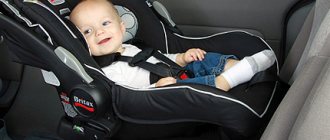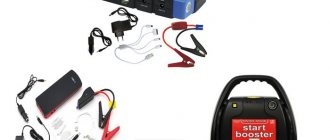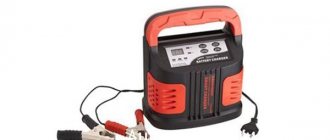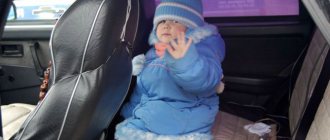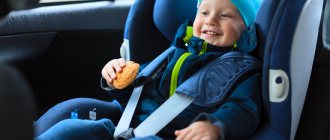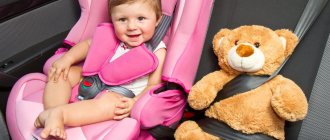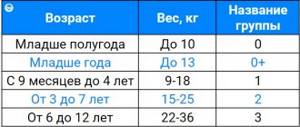What is a booster for children
A booster seat for children is a type of car child restraint system (CAC).
The main purpose is to artificially increase the height of a child in a sitting position to secure him with a standard seat belt, the standard design of which is designed for a person with a height of 150 cm.
The main function of a booster seat for children is to increase the safety of transporting children without the use of a full-fledged restraint device, which is achieved by complying with the following conditions:
- fixing the child’s position in the event of a possible collision using a stationary attachment of the pillow at three points;
- correct direction of the car seat belt - over the shoulder and hips;
- quick disembarkation of the child from the cabin.
It is an ergonomic seat with armrests, does not have a backrest or side protection, and uses the back of a car seat as a support. Subject to mandatory certification in accordance with GOST R 41.44 - 2005. or with the UNECE European Safety Standard No. 44-04.
It is allowed to place the booster in the direction of travel on the front or rear seats in accordance with the requirements of the operating manual for each individual device.
Child restraint
Transportation of children under 12 years of age in vehicles equipped with seat belts must be carried out using child restraints appropriate for the weight and height of the child, or other means that allow the child to be fastened using seat belts provided for by the design of the vehicle, and in the front seat passenger car - only with the use of child restraints. It is prohibited to transport children under 12 years of age on the back seat of a motorcycle.
Child restraint system (child restraint systems) a set of elements consisting of straps or flexible elements with buckles, adjusting devices, fastening parts and, in some cases, an additional device (for example, a cradle, a removable child seat, a booster seat and /or impact shield), which can be attached to the interior of the vehicle body.
The device must be designed in such a way that, in the event of a collision or sudden braking of the vehicle, the risk of injury to a child in the restraint is reduced by limiting the movement of the child's body.
Transporting children without special restraints is prohibited, regardless of whether they are provided for in the design of the vehicle or not.
Be sure to take your child with you and do not buy a chair without him. Place your child in a chair in a store and see if it is comfortable for him to sit there. Do not try to take the chair completely for growth. Remember that the health and life of your child is most valuable.
Now let's talk about other means of securing a child. Let’s make a reservation right away and say that there are no vehicles that do not have additional fastenings for seat belts. If you have an old Russian car, then seat belts are not installed in the rear seats, but this does not mean that you can transport children in the back.
Transporting children without special restraints is prohibited, regardless of whether they are provided for by the design of the vehicle or not. You can argue with the inspector as much as you like, but if your child is not “secured” in the car in any way, then you cannot avoid a fine.
People all know them as child seats (car seats), which are sold in almost every car store; they are all divided into groups:
| Group of chairs | Child's weight | Child's age | Characteristics of the car seat |
| 0 - 10 kg. | 0 - 1 year | “Car seat” In a horizontal position, the child is fastened with a wide belt across the stomach, in a folded position - with a three-point internal belt of the seat. | |
| 0+ | 0 - 13 kg. | 0 - 1.5 years | The chairs of this group are similar to the “Car seat”, however, the child is in a semi-recumbent position, and it can also be installed in two positions - both facing and with the back in the direction of travel. |
| 1 | 9 - 18 kg. | 1 – 4 years | These seats have internal five-point belts and are installed in the direction of travel of the vehicle. |
| 2 | 15-25 kg. | 3-7 years | The chairs have a high back, the height is adjustable as needed. The child is fastened with a standard seat belt along with the seat. |
| 3 | 22-36 kg. | 7-12 years | A chair from group 2 is suitable for this category if the child grows out of the backrest, it is detached and the result is a “Booster” chair. As a rule, it is equipped with a “limiter” for the upper strap of the car seat belt. |
At what age can a booster be used?
In accordance with clause 22.9 of the Traffic Regulations of the Russian Federation, the transportation of children is permitted:
- up to 7 years old - only using a child restraint system;
- from 7 to 11 years old - in the front seat - only with a child restraint system, in the rear - it is allowed to use only standard seat belts, without additional devices;
- from 12 years old - only seat belts are allowed.
In addition, the rules establish that each of the devices used must correspond not only to the age, but also to the weight and height of the child.
Depending on the age and weight of the child, in accordance with UNECE No. 44-04, all restraint devices are divided into groups:
- 0 – from birth to 6 months and weighing up to 10 kg;
- 0+ – from 6 to 12 months (up to 13 kg);
- I (1) – from 9 months to 4 years (9 – 18 kg);
- II (2) – from 3 to 7 years (15 – 25 kg);
- III (3) – from 6 to 12 years (22 – 36 kg).
A child booster seat without a backrest, in accordance with the amendment made to the UNECE Uniform Regulations No. 44-04 in 2021, can only be used as a restraint structure for group III (3).
Thus, it is allowed to use a booster to transport a child aged 6 to 12 years only in the back seat of a car, and its weight must be between 22 and 36 kg, and its height must be at least 125 cm.
In this case, you should consider the option of a booster when transporting a child over 12 years of age, provided that his height is less than 125 cm, since the standard seat belt should be at shoulder level and in no case in the neck area.
What is a booster and why is it needed in a car?
A booster is a type of restraint device in the form of a seat with small armrests, but without a supporting back and headrest. The purpose of the design is to lift the small passenger, and then the standard seat belt will not pinch his neck (which happens if the child is simply transported in a car seat).
The purpose of the booster is to raise the baby to the level of correct fixation with standard seat belts.
What the law says
According to the 2021 edition of the traffic rules, children under 12 years of age must travel in a car in a special restraint device that is suitable for their age and height and weight.
This is interesting. Article 12.23 Part 3 of the Code of Administrative Offenses states that transporting children without special restraint devices is punishable by a fine of 3 thousand rubles.
However, any homemade pillows and pads are not included in the recommended devices for transporting small passengers. In other words, the design to ensure the safety of a child in a vehicle must be certified and meet or exceed federal or state transportation standards.
Rules for using a booster depending on the height, weight in kilograms and age of the child
Like other types of devices designed to carry small passengers, it has clear parameters for use according to the age, height and weight of the child. To understand the features of its use, it’s worth first understanding the categories of restraint devices:
- 0 - car seats for newborns and infants up to six months. Designed for body weight up to 10 kg;
- 0+ - car carriers for babies up to one year old. Designed for body weight up to 13 kg;
- 1 - car seats used from one and a half to 3 years. Can withstand body weight of 9–18 kg;
- 2 - devices for preschoolers from 3 to 7 years old with a weight of 15 to 25 kg;
- 3 - products for children aged 6–12 years, weighing from 22 to 36 kg.
The booster belongs to categories 3 and 2, that is, it is suitable for a child from 3 to 12 years old, weighing from 15 to 36 kg. But the height of the passenger should not be lower than 120 cm.
Sometimes you hear about models with a backrest, but in fact such products are group 2/3 car seats, which, if necessary, can be transformed by removing the back part.
Booster in comparison with other restraint devices (car seat framed and frameless, FEST)
For long trips, the most suitable and comfortable seat will be a frame car seat. In terms of safety indicators, it also ranks first. All other restraint options do not provide lateral protection for the head and body.
If we talk about a frameless car seat and FEST, then the first device has shown its unreliability during independent tests (the belts that fasten the child break at the moment of a collision), and the second leads to injuries to the abdominal cavity (the belt raised by the adapter passes not over the reeds, but through the passenger’s stomach ) and does not protect against the diving effect.
Some parents install both a booster and FEST. Such reinsurance is not a violation, but it is not particularly advisable either.
Video: crash test of a booster, car seat and other devices
Booster markings
When choosing a booster, you should pay attention to its markings; if there are no markings, it is better not to buy such a booster. The marking, or simply the sticker label, carries important information.
Labeling of a children's booster is carried out in accordance with UNECE No. 44-04 and must have the following designations:
- color – orange or white;
- ECE-R44/04 – mark of product compliance with the safety standard;
- 22 – 36 – user weight category;
- 04 and further six-digit code – individual number of tests performed;
- E1-9 – a sign of official safety approval provided by one of the European countries;
- III – retention device group (Roman or Arabic numerals can be used).
Recently, booster packs were labeled “2/3”, indicating that the booster is designed for a child weighing from 15 to 36 kg. Nowadays, the use of boosters is prohibited for such young children, since their spine is not yet strong and they need lateral support. The booster is approved for the age group designated “3”, that is, for children weighing from 22 kg and height from 125 cm. The “2/3” marking is outdated and was canceled in 2017.
At what age can you travel without a booster?
The answer to this question is already clearly given to us by the 2021 traffic regulations:
- if the child is under 7 years old, then he can only be transported in a child booster seat or seat (in compliance with the latest UNECE rules No. 44-04),
- from 7 to 11 years old, children can be transported without boosters at all in the rear seats, and only in a booster or child seat in the front seat,
- From the age of 12, a child can ride, fastened only with a standard seat belt, in any seat.
You can, but you don't need to!
It should be borne in mind, however, as we have already mentioned above, that no fine can logically take precedence over the safety of children. And it’s not for nothing that the traffic rules mention the compliance of a child restraint system with the child’s height and weight.
The fact is that for many children over 7 years old, when they can be transported without a booster according to the Rules, the standard belt (top strap) runs exactly along the neck. This should not be allowed, since in an accident the risk of fatal injury is even higher than if the child were driving unbelted. To confirm this, you can watch the very first crash test video of the dummy below.
Therefore, the issue must be approached strictly individually - most often it is still recommended to use a booster seat or a child seat, regardless of how old the child is and whether this is in compliance with the traffic rules.
Also, if the Rules allow you to transport a child without a booster, but you use it for safety reasons, then the booster’s compliance with the rules is no longer critical for compliance with the law (but they still mean that the booster has passed the necessary tests and is safe for your child).
Something else useful for you:
- We drove under the camera at a yellow traffic light: will there be a fine and how to appeal?
- Is there a fine for driving on summer tires in winter and winter tires in summer today? What date will it start?
- Traffic regulations about passing a stationary car on a continuous road: what is the fine and is it possible to cross?
Booster material for children
The material used in the production of the booster determines its strength, long-term use and cost.
From foam plastic
Foam boosters have the following advantages:
- do not get wet;
- resistant to microorganisms (can be stored in a cold and damp place);
- have a small weight - up to 2 - 3 kg;
- have a low cost - up to 1000 rubles.
As a disadvantage, it is necessary to note the fragility of the material, and, as a result, the low level of protection, since when exposed to force, the foam does not hold its shape and crumbles.
Made of plastic
Boosters made of plastic have all the advantages of foam and are relatively cheap - their cost is 1500 - 2000 rubles. During sudden braking, they reliably hold the child in a fixed position, but in the event of an accident, an additional risk may arise - the material breaks into thin and sharp parts.
With metal frame
The disadvantages of a booster with a metal frame are its heavy weight and overall dimensions, but they do not matter when compared with the advantages:
- high degree of protection;
- resistance to impact;
- reliability of fixation.
In addition, such a booster has increased comfort, since its interior consists of several layers of polyurethane foam, which retains the shape of the body and gives softness.
Pros and cons of boosters
Using a baby booster undeniably has some advantages:
- comfortable placement of a child, especially at the age of 10 - 12 years;
- low cost - from 700 to 3000 rubles. depending on the material of manufacture;
- compactness;
- light weight – up to 5 kg;
- ease of installation and dismantling.
The booster has one drawback, but it plays a decisive role when choosing a child restraint system - the level of protection in the event of a possible accident is significantly lower compared to a child car seat due to the lack of lateral impact protection.
What is the penalty for incorrect transportation in a booster?
The fine for violations of the rules for transporting children for 2021 is general - it is 3,000 rubles under Part 3 of Article 12.23 of the Administrative Code. It will be issued to you if:
- You are transporting a child under 7 years of age in a vehicle without a booster seat or any other approved child restraint device,
- You are transporting a child from 7 to 11 years old in the front seat without these same devices,
- You are transporting an unbelted child over 12 years old,
- the child is sitting in the booster seat, but is not fastened or the booster itself is not fastened (in cases where this is provided for by the design of the booster itself).
This fine can be paid with a 50% discount during the first 20 days after the decision is issued (and later in some cases). The cameras do not record this traffic violation, and evacuation to the impound lot is not provided.
The peculiarity of this fine lies in two important subtleties:
- it can be prescribed every time the car starts moving (even by the same inspector), no days for elimination,
- If you are transporting 2 or more children without a booster or with other violations of the transportation rules, then only one fine should be assigned per stop, since the very fact of violating the transportation rules is punished specifically.
Expert opinion
Dmitry Tikovenko
Automotive law expert. 7 years of experience. Areas of specialization: civil law, disputes over compulsory motor liability insurance and road accidents
This article will be of interest not only to young mothers and fathers, but also to those who transport children for official reasons. We are talking about taxi drivers.
If you violate the rules for transporting children when providing transportation services in a taxi, then the driver will not get away with simply fines from the Administrative Code. This act can already be qualified as the provision of services that do not meet safety requirements, which means that the driver will be held accountable under another article and even under another code - criminal. In the code, this is Article 238, and the punishment here can be either a fine or imprisonment.
Ask a Question
How to choose a booster
When choosing a child booster, it is necessary, first of all, to focus on the safety, reliability and comfort of placing a child in the cabin.
Frame material
The frame material is hard: metal or plastic. In this case, the following conditions must be met:
- the pillow filler should be soft and hold the shape of the body;
- the surface of the seat should be evenly covered with ergonomic filler;
- The leading edge of the booster should be soft and sloping.
In addition, there are no obvious frame protrusions around the entire perimeter of the device that would impact a child under normal conditions.
Case material
Preferred characteristics of the cover material: wear resistance and hypoallergenicity. The use of natural fabrics that do not cause sweating and are able to absorb moisture increases the child’s comfort in hot weather. The removable cover guarantees timely cleaning and washing.
Armrests
The metal frame of the armrests should be covered with soft filling to create comfort. To reduce the risk of injury, the only condition must be met: the height of the armrest must correspond to the free position of the child’s arm, bent at a right angle.
Dimensions
The overall dimensions of a booster seat for children must correspond to the size of the child, since this is the basis for safe transportation:
- The length of the seat should be equal to the length of the legs with bent knees with full contact between the child’s back and the back of the car seat. If the length of the booster is longer, the child’s legs will be straightened, which is contrary to safety conditions. In addition, by bending his legs, the child will roll his back along the back of the car seat, which will lead to the seat belt moving from the shoulder to the neck or head - this position is strictly unacceptable. A similar situation will arise if the length of the seat is shorter - the lack of comfort will encourage the child to slide down the back.
- The width of the booster should correspond to the size of the child, taking into account the presence of warm clothing. Squeezing the body will cause pain, and the presence of free space will not allow you to securely fix the position.
Thus, before purchasing, it is advisable to place the child on the booster and check the compatibility of the sizes.
Seat belt corrector
The corrector is used to prevent the seat belt from moving in the event of an emergency. It is a triangular envelope that pulls two standard belts together. Required when the belt strap slips off the child’s shoulder and does not return spontaneously.
It can be used in extreme cases as an additional measure in conjunction with a booster, but is not an independent restraint device, since it shifts the calculated load on the belt and weakens its tension.
Mounting method
The safest way to secure a child booster seat in the cabin is the ISOFIX or LATCH system. It is certified and allows you to securely fix the booster on the car seat.
It is allowed to place the booster in the cabin using seat belts without additional fastening, however, this significantly increases the risk of injury in the event of an emergency.
Child's opinion
The child’s opinion is an important factor when choosing a booster, since only he himself will identify possible inconveniences in use:
- the presence of protruding parts of the frame;
- hardness or excessive softness of the seat;
- squeezing on the sides.
In addition, during testing it is necessary to check the compliance of the armrests and seat length with the child’s size, and also to identify the need to adjust the seat belt.
Which booster seat is best for children?
Comparing boosters with classic car seats, the advantages and disadvantages of the former become clear. The disadvantages include the lack of side walls that protect both the body and the head, although not all car seats are sufficiently equipped with them. But boosters have many advantages that their users note. These include lightness, compactness, ease of installation, price, they do not hinder the child’s movements so much, they can easily be found in a place for storage, even in the trunk of a car.
When choosing a booster, you only need to decide:
- With the weight and age of the child. Since there are those that are suitable for groups 2-3 (weight from 15-36 kg), and there are only for group 3 (weight from 22-36 kg).
- Mounting method in the car: Isofix or standard belts. Here, of course, the Isofix system has a big advantage, since with it the seat is always fixed on the car seat in the right place, and not just at the moment when the child is fastened.
- The presence of guides for the position of the seat belt. This is necessary so that the belt does not move off the child’s shoulder and does not put pressure on the neck, but is in the correct points.
- Width, despite the fact that all these seats are compact, there is still a difference in this parameter and for some it may seem significant.
- And the most insignificant parameters are the shape of the seat, the softness of the upholstery and the quality of the cover.
It is noticeable here that even more expensive boosters do not differ much from budget ones, and not all cars have the Isofix system, and this is also worth taking into account. Therefore, it remains to decide on the category, mounting method and design.
For trips over short distances, almost any booster from our rating is suitable; they will all provide reliable support for the child and a more comfortable height position.
And for longer trips, you should choose a device with an anatomically shaped seat and softer upholstery. Enjoy the shopping! Thanks to All.ru in Yandex Zen. Daily updates, subscribe, we have a lot of interesting things
Daily updates, subscribe, we have a lot of interesting things
Safety: differences between a booster and a car seat
Comparative characteristics affecting safety are given in the table:
| Index | Car seat | Booster pillow |
| Fastening | 5 points | 3 points |
| Rigid back for impact protection | There is | No |
| Side protection | There is | No |
| Head protection | There is | No |
| Fixation | tough | medium or low |
Thus, a car seat is a safer way to transport a child. It is recommended to buy and use a booster in the following cases:
- if the child is large and it is not possible to choose a chair;
- upon reaching 10 years of age;
- for taxi rides.
It is important to remember that mismatching the size of the booster significantly reduces the level of safety.
How to install a booster in a car
Installing a booster for children in the cabin consists of several stages and looks like this:
- clear the mounting holes on the car seat;
- install the booster tightly, secure;
- check the reliability of fixation;
- sit the child upright, place his hands on the armrests;
- fasten with a standard seat belt;
- Check that the seat belt is positioned correctly across the shoulder and hips.
If there are nuances when installing individual booster models, they will be reflected in the instruction manual - you should definitely read it.
The safety of a child when using a booster is significantly lower than when transporting him in a car seat. However, in some cases it is advisable to buy just such a device. The main rule is not to save money and choose a model responsibly.

